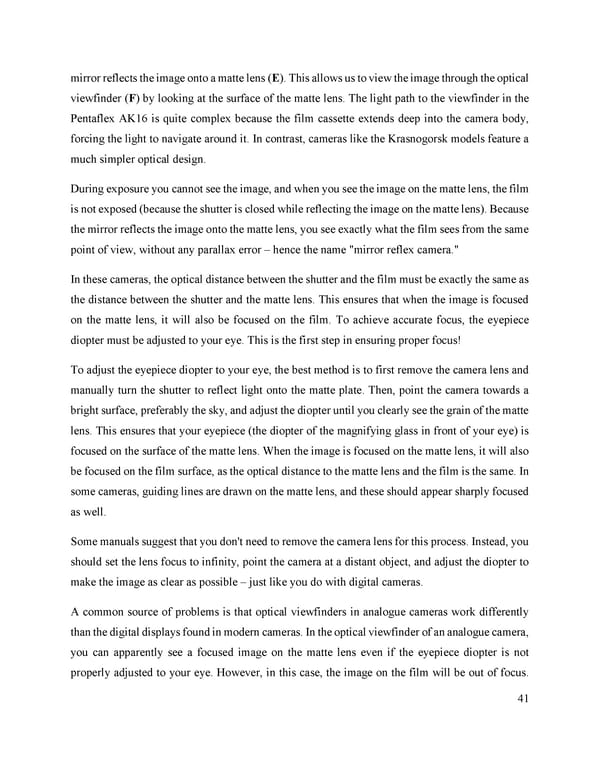mirror reflects the image onto a matte lens (E). This allows us to view the image through the optical viewfinder (F) by looking at the surface of the matte lens. The light path to the viewfinder in the Pentaflex AK16 is quite complex because the film cassette extends deep into the camera body, forcing the light to navigate around it. In contrast, cameras like the Krasnogorsk models feature a much simpler optical design. During exposure you cannot see the image, and when you see the image on the matte lens, the film is not exposed (because the shutter is closed while reflecting the image on the matte lens). Because the mirror reflects the image onto the matte lens, you see exactly what the film sees from the same point of view, without any parallax error – hence the name "mirror reflex camera." In these cameras, the optical distance between the shutter and the film must be exactly the same as the distance between the shutter and the matte lens. This ensures that when the image is focused on the matte lens, it will also be focused on the film. To achieve accurate focus, the eyepiece diopter must be adjusted to your eye. This is the first step in ensuring proper focus! To adjust the eyepiece diopter to your eye, the best method is to first remove the camera lens and manually turn the shutter to reflect light onto the matte plate. Then, point the camera towards a bright surface, preferably the sky, and adjust the diopter until you clearly see the grain of the matte lens. This ensures that your eyepiece (the diopter of the magnifying glass in front of your eye) is focused on the surface of the matte lens. When the image is focused on the matte lens, it will also be focused on the film surface, as the optical distance to the matte lens and the film is the same. In some cameras, guiding lines are drawn on the matte lens, and these should appear sharply focused as well. Some manuals suggest that you don't need to remove the camera lens for this process. Instead, you should set the lens focus to infinity, point the camera at a distant object, and adjust the diopter to make the image as clear as possible – just like you do with digital cameras. A common source of problems is that optical viewfinders in analogue cameras work differently than the digital displays found in modern cameras. In the optical viewfinder of an analogue camera, you can apparently see a focused image on the matte lens even if the eyepiece diopter is not properly adjusted to your eye. However, in this case, the image on the film will be out of focus. 41
 Lost Analogue: Exploring Film, Music, and Interdisciplinary Methods in Education Page 41 Page 43
Lost Analogue: Exploring Film, Music, and Interdisciplinary Methods in Education Page 41 Page 43